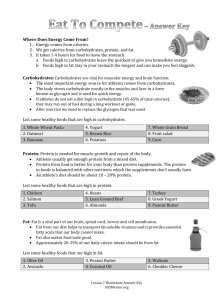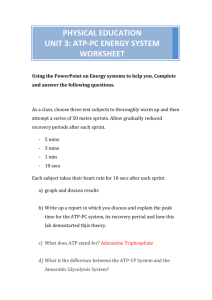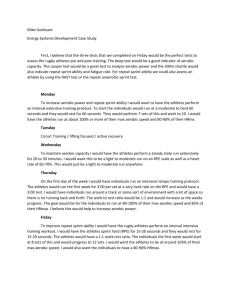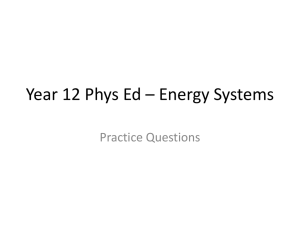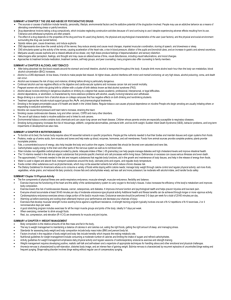UNIT 3- AOS 1: Monitoring and promotion of physical
advertisement
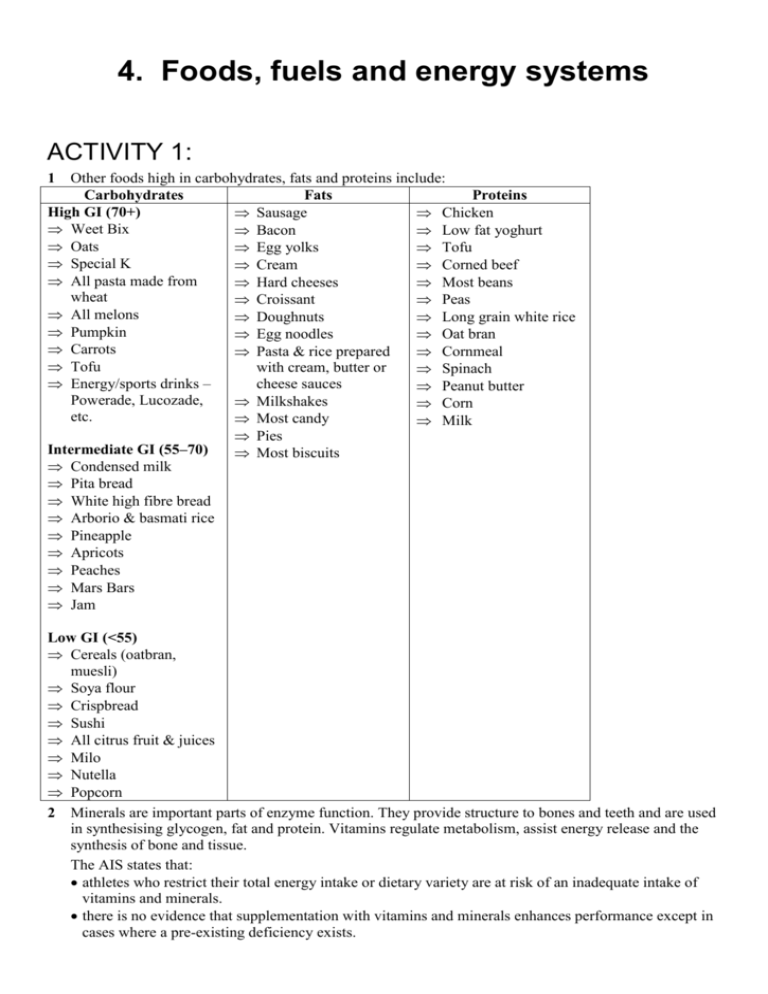
4. Foods, fuels and energy systems ACTIVITY 1: 1 Other foods high in carbohydrates, fats and proteins include: Carbohydrates Fats Proteins High GI (70+) Sausage Chicken Weet Bix Bacon Low fat yoghurt Oats Egg yolks Tofu Special K Cream Corned beef All pasta made from Hard cheeses Most beans wheat Croissant Peas All melons Doughnuts Long grain white rice Pumpkin Egg noodles Oat bran Carrots Pasta & rice prepared Cornmeal Tofu with cream, butter or Spinach Energy/sports drinks – cheese sauces Peanut butter Powerade, Lucozade, Milkshakes Corn etc. Most candy Milk Pies Intermediate GI (55–70) Most biscuits Condensed milk Pita bread White high fibre bread Arborio & basmati rice Pineapple Apricots Peaches Mars Bars Jam Low GI (<55) Cereals (oatbran, muesli) Soya flour Crispbread Sushi All citrus fruit & juices Milo Nutella Popcorn 2 Minerals are important parts of enzyme function. They provide structure to bones and teeth and are used in synthesising glycogen, fat and protein. Vitamins regulate metabolism, assist energy release and the synthesis of bone and tissue. The AIS states that: athletes who restrict their total energy intake or dietary variety are at risk of an inadequate intake of vitamins and minerals. there is no evidence that supplementation with vitamins and minerals enhances performance except in cases where a pre-existing deficiency exists. Situations for Vitamin/Mineral Supplementation for athletes: Athletes undertaking a prolonged period of travel, particularly to countries with an inadequate or otherwise limited food supply Athletes undertaking a prolonged period of energy restriction (e.g. 8MJ/1900 kcal for females or 10 MJ/2300 kcal for males) for weight loss, or weight maintenance Athletes with a restricted dietary intake who are unable/unwilling to increase food range Athletes with a heavy competition schedule, involving disruption to normal eating patterns 3 a The recommended food intakes in a balanced diet would vary under the following circumstances: Stage of development – different for babies, adolescents, 60+ year olds Level of activity – active people more likely to need higher amounts of carbohydrate and protein; inactive/sedentary people need to reduce amount of fat intake State of health – people experiencing ill health/injury need diets tailored to their condition to maintain well-being and promote recovery Access to foods – people with limited access to certain food groups would see variations to recommended intake b To investigate the food intakes of an indurance performer, go to http://www.ais.org.au/nutrition/documents/FuelDistance.pdf To investigate the food intakes of a power athlete, go to http://www.ais.org.au/nutrition/documents/FuelSprint.pdf 4 Comprehensive information related to vegetarian diets provided by the AIS can be found at http://www.ais.org.au/nutrition/documents/FactVeg.pdf 4. Foods, fuels and energy systems ACTIVITY 2: 1 Glycogen sparing assists endurance athletes by ‘conserving’ glycogen whilst more fats are oxidised/used at submaximal levels earlier on in the activity. This then allows for greater amounts of carbohydrates to be available later on in the performance and more oxygen to be available for working muscles. 2 a Body Mass Index (BMI) is recommended for assessing overweight and obesity and monitoring changes in body weight (National Institute of Health [NIH] 1998). In adults, a BMI greater than or equal to 25 is classified as overweight and a BMI greater than or equal to 30 is classified as obese (NIH 1998). In 1995, 63.7% of adult Australian men and 47.0% of women were overweight or obese. In children aged seven to 15 years, 15.0% of boys and 15.8% of girls were overweight and a further 4.5% of boys and 5.3% of girls were obese (Magarey et. al. 2001). In both adults and children, the prevalence of overweight and obesity has increased substantially since the 1980s (Eckersley 2001; Magarey et. al. 2001). b Ways in which participating in regular physical activity can have a cordioprotective beneift for overweight individuals include: Increases calories ‘burnt’ with associated reduction of body fat – less strain on the heart Increases HDL and lowers cholesterol levels Reduces links with diabetes and risk of heart attack Increased aerobic activities will lead to improved cardiovascular function (increased SV & Q; increased blood volumes, etc.) Educative process likely to also lead to ‘improved eating habits’ and continued participation in regular physical activity 3 Comprehensive information about carbohydrate (CHO)-loading regimes and practices is available as an AIS Fact Sheet at http://www.ais.org.au/nutrition/documents/factcload.pdf Other CHO loading ‘plans’ are similar to that of the AIS but sometimes: do not have a training/reduction ‘taper’ and hence don’t experience ‘loading’ require the person to ‘drain’ most stored carbohydrates via an intensive exercise bout the week before the ‘main’ event and then refueling (this is known as the depletion phase) – this is disruptive to the training schedule and increases likelihood of injury/non-recovery excessive amounts of carbohydrates with excess amounts being converted to fat make a person have to ‘work harder’ to release energy 4 Disadvantages associated with increased protein intake include: Taking up space of more ‘energy efficient’ carbohydrates from the diet Possible increased animal fat intake if non-vegetarian protein source used Increased kidney function and urinary water loss to remove proteins/nitrogen Greater energy requirements for digestion, absorption and fuel which elevates metabolism and may lead to increased body temperatures. 4. Foods, fuels and energy systems ACTIVITY 3: 1 Low-GI foods, by virtue of their slow digestion and absorption, produce gradual rises in blood sugar and insulin levels, and have proven benefits for endurance athletes by their slow release of energy over an extended period of time. Unlike high-GI foods, they do not result in rapid insulin increases and the associated use of glycogen, and allow endurance athletes to ‘burn’ free fatty acids early on in their performances. 2 High-GI foods would cause the endurance athlete’s performance to be below optimal due to: slowing of the central nervous system (transmission) reduced free fatty acid mobilisation increased use of glycogen. This would make it more likely that the endurance performer would be relying more on fats in the later part of the event/activity than would otherwise have been the case. ACTIVITY 4: 1 The ATP-PC system is readily available at the commencement of exercise because of the stored ATP and PC at muscles. There is no requirement for oxygen to be present and very few simple chemical reactions are required to release energy. 2 a The LA system is slower than the ATP-PC system in liberating energy because it requires glycogen to be broken down anaerobically and this involves more chemical reactions than those required to ‘split’ PC. b It is possible to use the lactic acid system repeatedly during exercise because the LA system calls upon glycogen to resynthesise ATP and as long as this is available it can function (anaerobically). The ATPPC system is ‘drained’ after approximately 10 seconds and cannot call upon PC to resynthesise ATP unless this has had time to recover (passively). 70% of PC is restored within 30 seconds, 90% within 90 seconds and 98–99% within 3 minutes. Anaerobic glycolysis sees lactic acid being formed and a small part of this is converted back into glycogen as it is broken down in the presence of oxygen. 3 It is advantageous to increase the number of mitochondria present at the muscular level because increased mitochondria are also associated with enzymes able to generate ATP aerobically. This in turn leads to an improved ability to sustain a high percentage of VO2 max. during endurance activities without the associated increase in lactic acid accumulation. 4 ‘Energy system interplay’ refers to all three energy systems working together to provide energy in varying amounts. For example, during a netball game the centre might be deriving energy from all three systems 10 seconds into the third quarter at the following rate: ATP-PC – 20%; LA – 60%; Aerobic – 20% During the later part of the same quarter this may have changed to: ATP-PC – 5%; LA – 30%; Aerobic – 65%. Students’ responses should highlight all three systems working to varying amounts depending on timing, intensity and fatigue/recovery mechanisms. Example: Ian Thorpe in the 400 m swim For the 400 m swim, as Thorpe takes off the blocks, the ATP-PC system is the major energy contributor for the first 8–10 seconds. As he continues to swim there is a transition period where the ATP-PC system drops off and the lactic acid system begins to take over to be the main energy supplier by the 10– 15 second mark. At the same time heart rate, respiratory rate, tidal volume, stroke volume, cardiac output and a VO2 difference are all increasing from resting values in an effort to increase oxygen supply to working muscles. As this occurs the aerobic energy system is increasing its contribution towards energy supply. By the one minute mark the aerobic system is the major energy contributor. However, as Thorpe increases his swimming speed in the last 100 m of the race the lactic acid system increases it’s contribution to energy supply until the end of the race. It is worth noting that when the aerobic system is activated it will produce more moles of ATP than any of the other two anaerobic systems and whilst the LA system is used increasingly during the final sprint to the wall, the aerobic system still resynthesises much more ATP (approx 40–50 times that of the LA system). The ATP-PC system is used sparingly after its first spurt because it has not had time to restore PC at any stage of the race.

